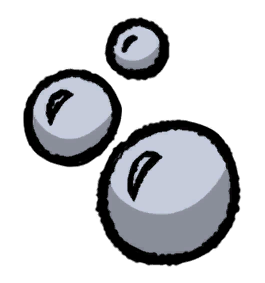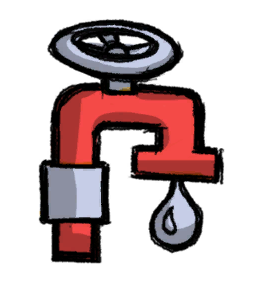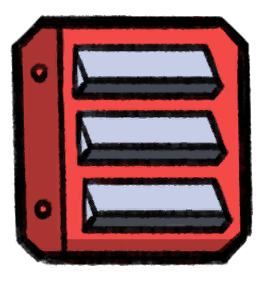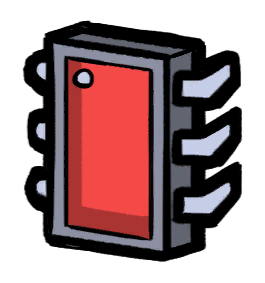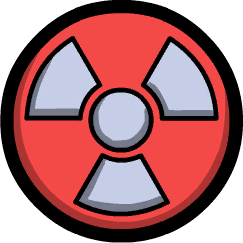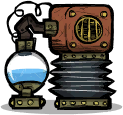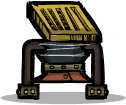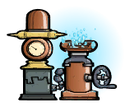Algae Terrarium
Algae Terrarium is used to produce Oxygen and remove a small amount of Carbon Dioxide (CO2 is not required to produce Oxygen). The Terrarium needs to be supplied Algae and Water to function, and Polluted Water has to be removed periodically.
Algae Terrariums do not have a maximum pressure and will continue to function as long as Water and Algae are available.
All resources output have a temperature of 30 °C86 °F (or higher if the inputs were hotter).
Usage
Algae Terrariums provide better conversion rates than the Oxygen Diffuser or Electrolyzer (with algae and water, respectively) and do not require power. Water delivery can be automated by dumping it on the floor through a Liquid Vent, and Algae delivery can be automated using Auto-Sweepers. However, the expulsion of Polluted Water must be done manually.
Ratios and Mechanics
- Algae Terrariums have slow individual oxygen generation rate, 12 or 13 of them are needed to match the Oxygen Diffuser's rate.
- Using any Light source to illuminate Algae Terrariums, will cause them to produce 10% more Oxygen, while still consuming the same amount of water and algae.
- One Algae Terrarium is capable of supporting 0.4 Duplicants. That is, you will need 5 terrariums per pair of Duplicants.
- Each Algae Terrarium consumes only 0.33 g/s of CO2. So for the purposes of scrubbing, 7 terraria are required per each Duplicant. Carbon Skimmers are one thousand times more efficient at this task. For context, it takes 2.5 Cycles for a Terrarium to clear the Carbon Dioxide generated from 1 second of a Petroleum Generator.
- Duplicants need to plunger the terrarium for every 360kg of polluted water stored in it.
- With proper Polluted Water recycling, the water to oxygen ratio of the Algae Terrarium is 1 to 4. That means you get a 400% return in oxygen on water spent. 300 g/s of water used, 290 g/s of polluted water returned = 10 g/s of water consumed to provide 40 g/s of oxygen. By comparison, the Electrolyzer converts water to oxygen only at the rate of ~90%.
- However, this is misleading as the 30g/s of Algae would have produced ~27g/s of Oxygen while consuming 0 water with an Oxygen Diffuser. So, the actual conversion is 40-27 = 13g/s of Oxygen per 10 g/s of Water, or a 130% conversion.
- One Water Sieve can recycle the output of ~17.2 Algae Terrariums.
- Comparison to other methods of oxygen production can be found at Converting Algae to Oxygen.
Tips
- Early reliance on Terrariums can prove disastrous to a colony:
- Water purification is not available yet and the Terrariums will eat through the Water supply.
- Automation and Auto-Sweepers are not available yet and thus the dupe labour will be immense.
- Combining Pufts + Morbs provides free Slime, which can be converted into Algae from the Algae Distiller. A full crowded Puft ranch (10 Pufts + 1 Prince) produces ~796 g/s Slime, which is converted to about 265 g/s Algae.
- 1 Algae Distiller is needed for every 6 Algae Terrariums.
- Carved Lumen Quartz produce easy and free light, which makes them a great choice for the Algae Terrariums.
- Algae Terrariums can be useful for creating an air-pocket in remote areas before an Atmo Suit is available, since they do not require power.
- Algae Terrariums consume large amounts of Water. Dump the Water on the floor thanks to a Liquid Vent to free the duplicants from this labour.
- Auto-Sweepers can be used to feed Algaes to the terrariums.
- Putting the Algae Terrariums inside a room and using automation to control the door will prevent Duplicants from refilling Algae Terrariums when it must be avoided, and prevent them from doing useless labour.
- To avoid the Popped Eardrum debuff, place an Atmo Sensor inside the room, controlling both the Door and the Liquid Vent.
- Automating the Liquid Vent is better than automating the Algae input, as Water only takes 2 cycles to deplete, while Algae takes 5. The Popped Eardrums debuff is more controllable that way.
- A Duplicant Motion Sensor can be placed in front of the door as a failafe, in the situation where the atmosphere pressure reaches the Atmo Sensor threshold while a duplicant is still inside the room doing, an Emptying errand. Place a tile out of the Water next to the Door/Motion Sensor, as the duplicant will pathfind into it to avoid the Soppy Feet debuff while Idling.
- Placing the Algae Terrariums near a polluted water reservoir will reduce the amount of time they spend transporting liquid.
- Alternatively, the bottled Polluted Water that is outputed can be separated with mechanized doors - so as not to interfere with oxygen generation - and left to emit Polluted Oxygen near Deodorizers. However, it does consume a lot more power as the falling Water has to be pumped back up. See example designs.
- If Polluted Water itself is sought, Algae terrariums can generate nearly 400kg per cycle per duplicant (but consume over 400kg of water while they're at it).
- If the water taken into an Algae Terrarium has germs, the oxygen produced will be infected, however the produced polluted water will have no germs. The polluted water can then be run through a sieve to reclaim germ free water.


